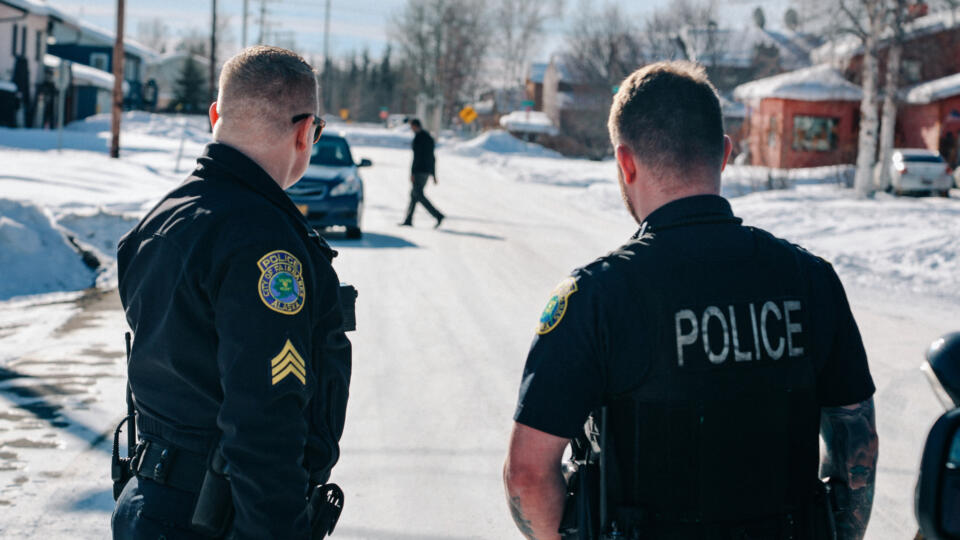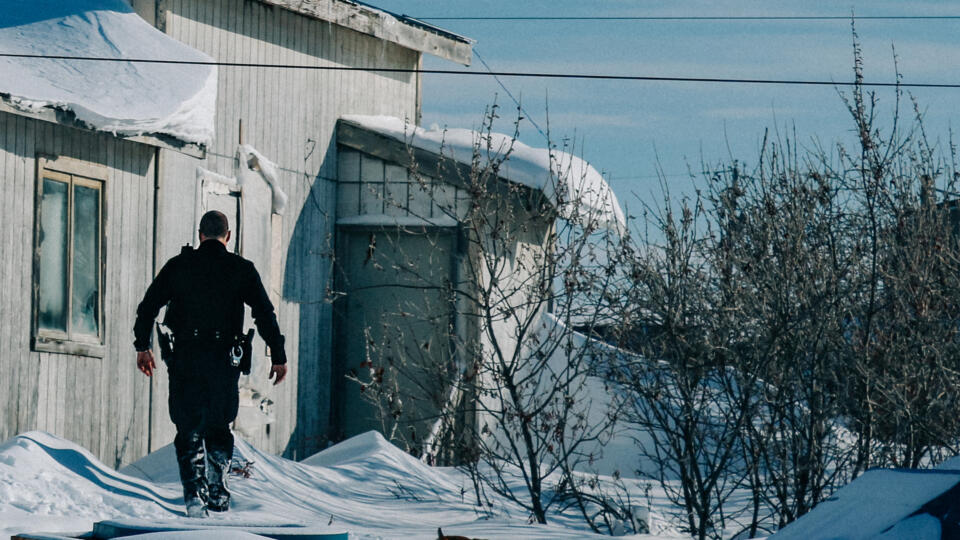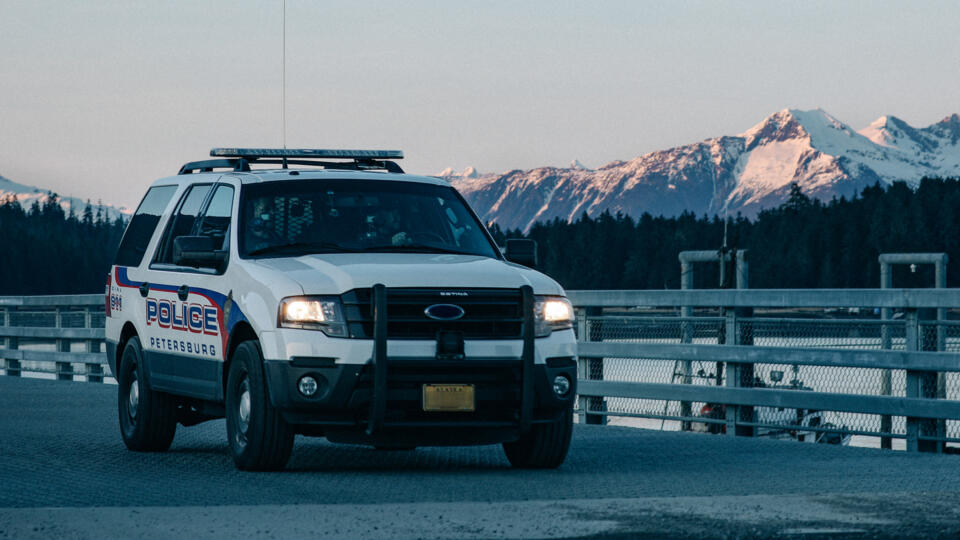To the average citizen, the idea of detaining a car burglar in the act is heart-stopping. Make that burglar 8 feet tall, 900 pounds and with claws that are thick as cigars, and the danger feels otherworldly.
But for Mike Sortor, a patrol sergeant for the Kodiak Police Department, it's just a day on the job.
Sortor helps protect the City of Kodiak (pop. 5,968) from some 1,700 Kodiak brown bears who live on Kodiak, a small island in the Gulf of Alaska, just off the state's south coast.
"We're right on nature's doorstep," Sortor says. "What becomes commonplace for us is not necessarily what [people] in New York would experience."
Sortor's police work on Kodiak—and that of other officers across the northernmost U.S. state—is featured on A&E's show "Alaska PD." (Watch full episodes here.)
A&E looks at some of the biggest challenges that police officers face in the Land of the Midnight Sun.
Gigantic Creatures
In Kodiak, brown bears are such a constant threat that Sortor says the police department is familiar with the worst offenders and has names for them.
"Right now, we have three that we're dealing with in town: the little bear, the big bear and the lanky bear," Sortor says.
"The big bear is the biggest concern," he adds. "It's ripping off car doors and stuff. That's kind of the line we draw—once they start intruding on vehicles. When the bear becomes a burglar."
Sortor says that because the big bear is so accustomed to people, his department has a "kill order." But applying lethal force in the middle of town to a top predator isn't easy.
"What if I don't kill the bear right away? What if I miss?" Sortor asks. An injured bear, he says, would be far more dangerous than a healthy one.
Sortor says the department rarely resorts to lethal force, instead directing its focus to "hazing" untoward bears: firing rubber bullets and/or low-power fireworks at the creatures to scare them off.
In the state's interior, Lieutenant Peyton Merideth of the Fairbanks Police Department says megafauna will also impose on city limits…but that it's moose that pose the greatest risk to people.
Aggressive attacks are rare, but moose—which can weigh up to 1,600 lbs. and stand 6 feet tall while still on all fours—can be deadly to encounter even when they aren't attacking, by the sheer force of their enormity.
"They get hit" by cars, Merideth explains. "Especially in the winter: It's dark, so you can't see them. And what'll happen is, the moose are so big that if the moose is hit by a passenger car, it'll take the moose's legs out from under them, and then the moose lands back on the windshield and will crush somebody."
Sortor says that for all the sensational images that animal-on-human violence conjures, it's a "drop in the bucket" for his department in Kodiak.
"I worry a lot more about things that go on two legs than four," he says.
The Wildest West
By state, Alaska has the highest violent crime rate in the country. Merideth attributes that lawlessness to the kinds of characters attracted to a second life in a place like Fairbanks.
"Fairbanks is kind of the end of the road," Merideth says. "A lot of people come up here to be away from society. They think the law doesn't apply to them; there's a lawless atmosphere."
Merideth says rampant alcohol abuse exacerbates the problem. In addition to being one of the most violent states in the country, Alaska is also one of the drunkest.
"We're up in the middle of nowhere," says Merideth. "So people drink a lot."
In Kodiak, Sortor says the frontier spirit also brings a transient population, especially in the summer, when the fishing industry booms and there's quick money to be made for unskilled laborers. That population turnover makes the island an easy place for outlaws to hide.
"Everybody is used to the characters. They come in, work, do their thing and then go. That makes it really challenging, because if you have a transient from the lower 48 with a warrant, they can blend in... It's a very good place to run away and hide."
In Kotzebue, an Alaskan town that's more than 30 miles north of the Arctic Circle, citizens also regularly turn that violence against themselves, says Sergeant Norman Hughes of the Kotzebue Police Department.
"We have a lot of suicides," Hughes says. "Anytime we have a suicide or a suspicious death, we have to ship them to the medical examiner's in Anchorage."
There are no roads in to Kotzebue—only boat and plane access—so the bodies get flown to the medical examiner via Alaska Airlines.
Dangerous Weather and Undermanned Departments
In large cities like New York and Chicago, summertime can herald violence; with more people outside in public spaces, violent crime rises. But in Alaska, the winter brings its own dangers.
In Fairbanks, Merideth says, brutal winter temperatures add an additional layer of difficulty to police trying to stay out of harm's way.
"We all carry survival gear: warm hats, big gloves," Merideth says. "But you can't dress so heavy in clothes that you can't manipulate your gun." In a city with average January lows of -17°F, that makes dressing for the job tricky.
In Kotzebue, Hughes says the constant blizzard threat makes policing particular challenging.
"We have a lot of blizzards," Hughes says. "And on days like that, it's hard to even get to the calls… Usually when we have a blizzard, it's high winds and snow at the same time. Some roads just kind of disappear."
Hughes says Kotzebue's police department is so undermanned that only one officer works at a time. So if that officer's vehicle gets stuck in the weather, the town is without law enforcement. As such, when there's threat of a blizzard, the department only responds to calls in absolute emergencies.
Kodiak's department is similarly undermanned.
"It's just one or two of us," Sortor says. "We're outnumbered. Compound that with the fact that you might be [patrolling] on a boat in a harbor at night—where no one can hear you scream."


